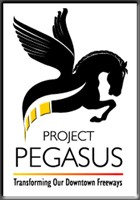- The traffic problems in the Canyon/Mixmaster
are worsened by the outdated, geometric layout of the main
travel lanes, service roads, ramps, and surface streets
in the area, all of which fail to properly provide for the
routes and destinations of current-day travelers. Secondary
problems include forced lane changes, abrupt and unexpected
merges, weaves and exits, and poor access for emergency
vehicle response. Additionally, the Mixmaster is missing
direct connections from eastbound IH30 to southbound IH35E
and from northbound IH 35E to westbound IH30.
Traffic problems in the area are the result of many causes,
including high regional population growth, changing employment
patterns, lack of alternative routes, increasing two-worker
household (trips), and high use of single-occupant vehicles.
These problems result in many effects, including slow travel
speeds, extended hours of congestion, increases in both accidents
and air pollution, as well as a particular local concern;
poor attraction of business and/or development to the area.
Congestion within the region also slows travel for many miles
along the radial freeways feeding into the downtown area,
such as IH 35E (Stemmons and South R.L. Thornton Freeways),
US 75 (North Central Expressway), and IH 30 (Tom Landry Highway
and East R.L. Thornton Freeway). If the downtown congestion
dilemma is not solved, the bumper-to-bumper conditions are
forecast to worsen to nearly 9 hours of congestion each weekday,
resulting in an actual overlap of the morning and evening
peak-hour flows. In other words, continuous congestion
throughout each workday, regardless of travel direction.
However this problem is not isolated, nor independent. Without
a transportation solution to the downtown freeway congestion,
proposals and/or designs for improving the outlying segments
of IH 30 and IH 35E (feeding into the same downtown bottleneck)
will not be effective, and thus cannot be implemented.
Current Design
Originally designed in the 1950's, the Canyon, Mixmaster,
and Lower Stemmons freeways were constructed between 1958
and 1962. At that time, downtown Dallas was the primary destination
of the majority of local freeway travelers. So much so, that
the adjacent freeway system was designed accordingly. Planners
and designers must now attempt to solve the demands of current-day
travel patterns, the least of which entails the fact that
4 out of every 5 travelers now remain on the freeways and
bypass downtown Dallas.
No significant improvements to roadway capacity have been
made since the freeways were originally constructed. Minor
improvements such as converting the inside shoulders to travel
lanes were made, but are considered interim improvements until
a long-term solution can be provided.
The design standards for freeways and Interstate Highways
have changed since the roadways were originally constructed.
In many locations, ramps do not have adequate acceleration
or deceleration lengths, interchanges and ramps are too close
together, bridges have limited vertical and horizontal clearances,
and the freeway has poor sight distances.
Traffic problems are made worse by the layout of main lanes,
service roads, ramps, and surface streets in the area, which
do not properly provide for the major traffic demand routes
and destinations. Forced lane changes, abrupt and unexpected
merges, short weaves and quick exits compound the problems.
More people means more cars...
Population of the five-county Dallas-Fort Worth region increased
dramatically between 1960 and 2000. In 1960, the population
of Dallas County was over 950,000 and the combined population
of the five urban counties in North Central Texas (Dallas,
Tarrant, Denton, Collin, and Rockwall) was 1.63 million people.
In 2000, the population of Dallas County was 2.22 million
and the combined population of the five counties was 4.63
million people. This is more than a doubling of the Dallas
County population in 40 years. The North Central Texas Council
of Governments estimates that the region's population will
double within the next 20 years.
Traffic on IH 30 and IH 35E has increased at a rate of 1
to 5 percent each year. In 1999, over 155,000 vehicles a day
traveled the Canyon, with 286,000 vehicles utilizing IH 35E,
just south of the Dallas North Tollway.

The Canyon, Mixmaster and Lower Stemmons corridors were studied
as part of the Trinity Parkway Corridor Major Transportation
Investment Study (MTIS) conducted from 1996 to 1998. The purpose
of the MTIS was to develop a solution to the congestion in
the IH 30 Canyon and IH 35E/IH 30 Mixmaster interchange near
downtown Dallas and adjacent to the Trinity River Corridor.
The project evaluated numerous travel modes; considered over
40 improvement alternatives; included conceptual design, traffic
analysis, and environmental studies; and included an extensive
public and agency involvement program.
The final MTIS recommendation included over $1 billion in
multi-modal transportation improvements to the Mixmaster interchange
and IH 30 and IH 35E freeways, extending the Spur 366 (Woodall
Rodgers Freeway), high occupancy vehicle (HOV) lanes, a new
location parkway/reliever route, light rail, bicycle and pedestrian
improvements, Intelligent Transportation Systems, and employer
trip reduction programs. The MTIS recommendation was unanimously
approved by the Dallas City Council, Dallas County Commissioners
Court, the Dallas Area Rapid Transit (DART) Board, and North
Central Texas Council of Governments (NCTCOG) Regional Transportation
Council, and endorsed by the US Army Corps of Engineers.
It would be difficult for one agency to design and built
all of the recommended improvements. Several elements of the
recommendation are being studied further by the agencies that
will be responsible for building, operating, and maintaining
them. For example, DART is currently preparing the environmental
studies and preliminary engineering for the light rail element,
known as the Northwest Corridor. The North Texas Tollway Authority
(NTTA) is preparing the environmental studies and preliminary
engineering for the new location parkway/reliever route, known
as the Trinity Parkway. And Project Pegasus will address improvements
to the existing Mixmaster interchange and IH 30 and IH 35E
freeways, including accompanying high occupancy vehicle (HOV)
lanes, Intelligent Transportation systems (ITS), bicycle and
pedestrian improvements, and Employer Trip Reduction (ETR)
elements.

The primary objective of Project Pegasus is to relieve traffic
congestion along IH 30, IH 35E, and throughout the Mixmaster
interchange. The goals for the project include:
- Maximizing the traffic carrying capacity of the freeway
system by integrating high occupancy vehicle (HOV) lanes,
intelligent transportation systems (ITS), Transportation
Systems Management (TSM), and TDM elements into the design;
- Minimizing the need for additional right-of-way;
- Providing more reliable transportation facilities by decreasing
congestion and travel times;
- Improving interregional connections to existing and proposed
roadways and transit facilities;
- Enhancing travel and accessibility to downtown Dallas,
major employment areas and activity centers within the corridor;
- Enhancing bicycle and pedestrian access across the facilities;
- Integrating urban design elements to reflect the character
and location of the surrounding communities;
- Developing a technically and financially feasible solution.





